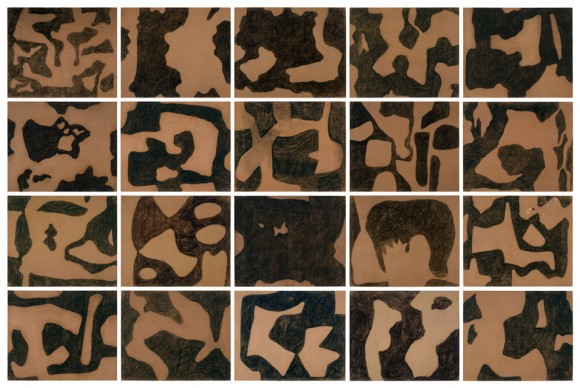Exhibition of Rarely-Seen Drawings Explore Noted Sculptor, Tony Smith’s Early Work at the Menil Collection
December 18, 2010 by All Art News
Filed under Art Events & Exhibitions
HOUSTON, TX.- On view at the Menil Collection from December 17, 2010 through April 3, 2011, Tony Smith: Drawings brings together a group of rarely-exhibited works on paper by the American artist best known for monumental geometric sculptures in steel and bronze.
Created between 1950 and 1955, the 30 drawings on display encapsulate a dramatic turning point in Smith’s artistic career, as he shifted from his professional architectural work towards painting and sculpture. Throughout this brief yet remarkably productive period, Smith laid the formal and theoretical groundwork for some of the most essential sculptures of the mid-twentieth-century.
Born in South Orange, New Jersey, in 1912, Smith was stricken with tuberculosis in early childhood – a circumstance, the artist recalled, that allowed him to develop his penchant for art and architecture in quiet isolation. After coursework at Fordham and Georgetown universities, Smith pursued his long-standing artistic interests at the Art Students League of New York, studying under painters George Grosz and Václav Vytlačil in the evenings while working as a draftsman at his family’s manufacturing company during the day.
Eventually heeding his father’s wishes, Smith moved to Chicago in 1937 to pursue a professional degree in architecture at the New Bauhaus, the reestablished incarnation of Germany’s famed design academy. Dissatisfied by the school’s highly scientific curriculum under the directorship of photographer László Moholy-Nagy, Smith left the New Bauhaus after a year to join the offices of Frank Lloyd Wright as a design apprentice. Though lacking in formal training and official certification, Smith established himself as an independent architectural designer, realizing more than twenty commissions over a two-decade period.
Smith moved to New York in 1945, as Abstract Expressionism began to coalesce around painters with whom the artist would establish and maintain close friendships, including Barnett Newman, Jackson Pollock, Mark Rothko, and Clyfford Still. Though he had yet to claim himself as an artist, opting instead for the title of “designer,” Smith shared a strong philosophical and aesthetic sensibility with the New York School painters that led to a variety of collaborations. In addition to creating several early examples of white-cube style exhibition spaces for his Abstract Expressionist associates, he also designed studios for Theodoros Stamos and renowned art dealer Betty Parsons. These close working relationships had a significant impact on Smith’s theories and practices, as evidenced in the gestural and ethereal qualities present in the works on view in Tony Smith: Drawings.
Smith’s interest in the principles of organic geometric order devised by 19th bio-mathematician D’Arcy Thompson are equally apparent throughout the exhibition – particularly in the artist’s modular arrangements of biomorphic forms. Together measuring almost 10 feet high and 16 feet in length, Smith’s Untitled, 1954 series of twenty drawings depicts an evolution of form and perpetual growth, a theme he pursued throughout his career. Reminiscent of an architect’s site plan or a topographical map, swirling archipelagos of black charcoal cover the individual sheets of paper arranged in a 4-by-5 foot grid. The irregular interlocking shapes appear to build upon, suspend and support one another, evoking a sense of organic reproduction.
Created during Smith’s time in Germany between 1953 and 1955, two untitled pastels hint at the artist’s work with Frank Lloyd Wright, whose infinitely expansive system of hexagonal modules Smith previously adapted for an unrealized building collaboration with Jackson Pollock in 1951. A honeycomb of jewel tone reds, blues, and greens is packed tightly onto the paper. Three other pastels from the same period express a similarly bold palette, showing large swatches of color tightly contained in amorphous forms. As seen in many works on display in the exhibition, gestural mark making is counterbalanced by an underlying rational order and controlled linear boundaries.
Organized by Bernice Rose, Chief Curator of The Menil Collection’s Drawing Institute and Study Center, Tony Smith: Drawings offers a unique lens through which to view the artist’s large outdoor sculptures permanently installed on the Menil campus (at the Loretto Street greenspace, just north of Richmond Hall). These works maintain an integral place in Menil history: John de Menil underwrote the fabrication of Smith’s first large-scale sculptures, The Elevens Are Up (1963, fabricated 1970) and Wall (1964, fabricated 2000), which the artist’s estate gave to the museum in 2001, in memory of Dominique de Menil.

